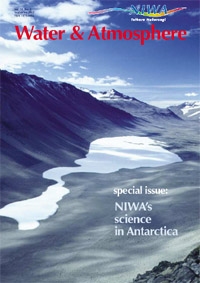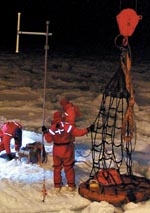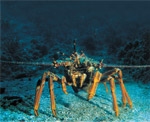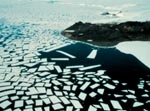PDF of this article (118 KB)

Tim Haskell
The seasonal cycle of freezing and thawing of Antarctic sea ice has far-reaching effects.
Sea ice is no ordinary ice. Not only does it cover vast areas in both polar regions, but it also has a unique structure. Both these features mean that sea ice has significant effects on the environment of the entire planet.
Climate scientists now consider that sea ice is crucial to the regulation of the Earth’s climate. Biologists believe that the Antarctic sea ice is the driving force behind the biological productivity of the Southern Ocean. It’s a circular system: the pack ice influences characteristics of the Southern Ocean, the atmosphere and the biosphere. But the distribution and characteristics of the ice itself depend on conditions in the atmosphere and ocean, such as temperature, wind and salinity. The ice may also be influenced by organisms living inside it. All of these variables therefore have the potential to play a significant part in global climate.
Huge annual change
Every year, sea ice on the Southern Ocean expands from a minimum of around 4 million km2 at the end of summer to a maximum of around 19 million km2 at the end of winter. This is one of the largest annual geophysical changes on the surface of the Earth. At its maximum, the sea-ice cover can extend 2200 km from the Antarctic coast or as little as 300 km depending on local climate and sea conditions. Competition between the formation of the ice by freezing and its breakup by the legendary violence of the Southern Ocean make this one of the Earth’s most active and variable regions.

As sea ice forms, it cools the water around it and thus makes a significant contribution to Antarctic cold bottom water (the most common water mass in the ocean). This in turn adds to the currents of the Southern Ocean (see “From icebergs to pongas”). When these nutrient and oxygen-rich currents upwell in more temperate latitudes, they become important in supporting higher forms of marine life.
Research into sea ice
New Zealand-based research into the various aspects of sea ice is a collaborative affair. A group including Industrial Research Limited and NIWA, and the Universities of Auckland, Victoria and Otago has worked together for over ten years. Most of the field work has taken place on the fast ice extending from the land over McMurdo Sound, although some work has been undertaken from ice breakers in the Southern Ocean.
The research programme looks at the formation of sea ice, its thermal properties and its break-up.

How does sea ice form?
Different kinds of sea ice form under different conditions. In the waves of the Southern Ocean a thin ice “skim” on the freezing surface of the ocean rapidly forms into pancakes of ice as the waves move the ice around. In the calmer conditions closer to land, the main form of sea ice is columnar ice. This matrix of pure ice platelets, interleaved with brine-filled inclusions, is also commonly seen in the Arctic. Deeper in the sea ice sheet, an open-textured type of ice, called platelet ice, appears. This ice type is associated with the proximity to an ice shelf and is rare in Arctic waters. The appearance of platelet ice in McMurdo Sound and its association with the oceanographic influence of the Ross Ice Shelf has been the subject of a recent winter study by the group. Understanding the formation process of sea ice provides us with information to better appreciate its structure and hence thermal processes.
Thermal processes
In McMurdo Sound, closer to Scott Base, where we are able to camp on sea ice (below), we have also been able to conduct experiments and build a mathematical model describing the processes that are largely responsible for the break-up of fast-ice sheets. As well as measuring the effects of natural sea waves on sea ice, we have also investigated the effects of generating waves in the sea ice by artificial means. To do this New Zealand scientists have developed engineering techniques that provide a cyclic loading on the sea-ice sheet to study mechanical properties of the ice and predict the mechanisms leading to its break-up.

Climate models currently include calculated values of the heat exchange between sea ice and the ocean. Field measurements are aimed at making these calculations more reliable. We have identified two important small-scale effects that are not taken into account in the current sea-ice model: disorder in the ice crystals, and convective transport of heat in the small liquid fraction present near the ice–water interface. Our data have encouraged sea-ice physicists and modellers to reassess the influence of the assumed thermal conductivity of sea ice. For example, adjusting the value of thermal conductivity by 30% (comparable to the difference between our results and the predictions) can change predictions of the total sea-ice thickness by about 20% and the summer open-water period by about 50%. It is therefore clearly important for global climate models to develop a more reliable picture of heat flow in sea ice.
Break-up processes

The two areas of interest in the break-up processes are the marginal ice zone (the outer reaches of the pack ice where the ocean swell is greatest), and the boundary between the inner reaches of the pack ice and the fast ice, which is generally much closer to the Antarctic continent. We have developed computer models for the marginal ice zone to describe how the interacting floes can absorb and dissipate the energy from incoming waves. This has helped us to understand how the zone effectively protects the sea-ice sheet behind it from the ravages of the waves. An analogy is in the way in which floating breakwaters protect marinas. The US Antarctic Programme has made most of the experimental work possible by giving us ship-time on to their ice-strengthened research vessels.
Influence on New Zealand
Sea ice is relevant to New Zealand because any changes in its characteristics, volume or area can potentially influence Antarctic Circumpolar Currents. These current flows are some of the largest in the oceans and are drivers of many other global current systems (see “From icebergs to pongas”). Minor changes in any of these current patterns could have rapid and significant effects on weather almost anywhere on earth. Climate models still struggle to work well at high latitudes, and a greater understanding of the sea ice–ocean–atmosphere system will help to improve these models and our understanding of, and predictions for, New Zealand climate systems.
Teachers: this article can be used for NCEA Achievement Standards in Geography (1.1, 2.1, 3.1), Science (3.5). See other curriculum connections at www.niwa.co.nz/pubs/wa/resources
Tim Haskell is based at Industrial Research Ltd in Wellington.
